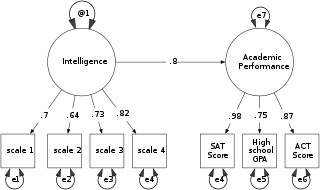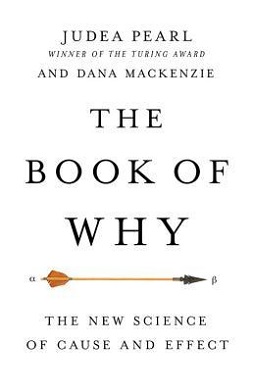Causality is an influence by which one event, process, state, or object (acause) contributes to the production of another event, process, state, or object (an effect) where the cause is at least partly responsible for the effect, and the effect is at least partly dependent on the cause. In general, a process can have multiple causes, which are also said to be causal factors for it, and all lie in its past. An effect can in turn be a cause of, or causal factor for, many other effects, which all lie in its future. Some writers have held that causality is metaphysically prior to notions of time and space.
Causality is the relationship between causes and effects. While causality is also a topic studied from the perspectives of philosophy and physics, it is operationalized so that causes of an event must be in the past light cone of the event and ultimately reducible to fundamental interactions. Similarly, a cause cannot have an effect outside its future light cone.
The language of thought hypothesis (LOTH), sometimes known as thought ordered mental expression (TOME), is a view in linguistics, philosophy of mind and cognitive science, forwarded by American philosopher Jerry Fodor. It describes the nature of thought as possessing "language-like" or compositional structure. On this view, simple concepts combine in systematic ways to build thoughts. In its most basic form, the theory states that thought, like language, has syntax.

Emergentism is the belief in emergence, particularly as it involves consciousness and the philosophy of mind. A property of a system is said to be emergent if it is a new outcome of some other properties of the system and their interaction, while it is itself different from them. Within the philosophy of science, emergentism is analyzed both as it contrasts with and parallels reductionism. This philosophical theory suggests that higher-level properties and phenomena arise from the interactions and organization of lower-level entities yet are not reducible to these simpler components. It emphasizes the idea that the whole is more than the sum of its parts.

The Granger causality test is a statistical hypothesis test for determining whether one time series is useful in forecasting another, first proposed in 1969. Ordinarily, regressions reflect "mere" correlations, but Clive Granger argued that causality in economics could be tested for by measuring the ability to predict the future values of a time series using prior values of another time series. Since the question of "true causality" is deeply philosophical, and because of the post hoc ergo propter hoc fallacy of assuming that one thing preceding another can be used as a proof of causation, econometricians assert that the Granger test finds only "predictive causality". Using the term "causality" alone is a misnomer, as Granger-causality is better described as "precedence", or, as Granger himself later claimed in 1977, "temporally related". Rather than testing whether Xcauses Y, the Granger causality tests whether X forecastsY.

Structural equation modeling (SEM) is a diverse set of methods used by scientists doing both observational and experimental research. SEM is used mostly in the social and behavioral sciences but it is also used in epidemiology, business, and other fields. A definition of SEM is difficult without reference to technical language, but a good starting place is the name itself.

Integrative criminology reacts against single theory or methodology approaches, and adopts an interdisciplinary paradigm for the study of criminology and penology. Integration is not new. It informed the groundbreaking work of Merton (1938), Sutherland (1947), and Cohen (1955), but it has become a more positive school over the last twenty years.
Strategic thinking is a mental or thinking process applied by an individual in the context of achieving a goal or set of goals. As a cognitive activity, it produces thought.

In metaphysics, a causal model is a conceptual model that describes the causal mechanisms of a system. Several types of causal notation may be used in the development of a causal model. Causal models can improve study designs by providing clear rules for deciding which independent variables need to be included/controlled for.

The mind–body problem is a philosophical problem concerning the relationship between thought and consciousness in the human mind and body.

Roger L. Martin is the former Dean of the Rotman School of Management at the University of Toronto from 1998 to 2013 and an author of several business books. Martin has expanded several important business concepts in use today, including integrative thinking. He has been recognized by several business publications as one of the field's most important thinkers.
Integrative neuroscience is the study of neuroscience that works to unify functional organization data to better understand complex structures and behaviors. The relationship between structure and function, and how the regions and functions connect to each other. Different parts of the brain carrying out different tasks, interconnecting to come together allowing complex behavior. Integrative neuroscience works to fill gaps in knowledge that can largely be accomplished with data sharing, to create understanding of systems, currently being applied to simulation neuroscience: Computer Modeling of the brain that integrates functional groups together.

The Opposable Mind: How Successful Leaders Win Through Integrative Thinking is a book written by Roger Martin and published by the Harvard Business Review Press in 2007. The book aims to introduce a concept of integrative thinking, using academic theory and insights from prominent business leaders to substantiate the idea.
Causal reasoning is the process of identifying causality: the relationship between a cause and its effect. The study of causality extends from ancient philosophy to contemporary neuropsychology; assumptions about the nature of causality may be shown to be functions of a previous event preceding a later one. The first known protoscientific study of cause and effect occurred in Aristotle's Physics. Causal inference is an example of causal reasoning.
Gregory Scott Berns is an American neuroeconomist, neuroscientist, professor of psychiatry, and psychologist. He lives with his family in Atlanta, Georgia, US.
The Design of Business: Why Design Thinking is the Next Competitive Advantage is a 2009 book by Roger Martin, Dean of the University of Toronto's Rotman School of Management. In the book, Martin describes the concept of design thinking, and how companies can incorporate it into their organizational structure for long term innovation and results.
There have been many criticisms of econometrics' usefulness as a discipline and perceived widespread methodological shortcomings in econometric modelling practices.
Causal inference is the process of determining the independent, actual effect of a particular phenomenon that is a component of a larger system. The main difference between causal inference and inference of association is that causal inference analyzes the response of an effect variable when a cause of the effect variable is changed. The study of why things occur is called etiology, and can be described using the language of scientific causal notation. Causal inference is said to provide the evidence of causality theorized by causal reasoning.
Causation in Sciences Project (CauSci) is a four-year interdisciplinary research project on the field of causation in the philosophy of science, funded by the Norwegian Research Council (NFR) and hosted by the School of Economics and Business at the Norwegian University of Life Sciences (NMBU).

The Book of Why: The New Science of Cause and Effect is a 2018 nonfiction book by computer scientist Judea Pearl and writer Dana Mackenzie. The book explores the subject of causality and causal inference from statistical and philosophical points of view for a general audience.








